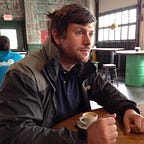ANTHROPOLOGIE: The Construction of Myth
There is a scene in Life of Pi where the character, Pi, finds himself awake at night, surrounded by all types of sea creatures. These sea creatures emit a wondrous translucent blue hue and backdrop to the darkened Pacific Ocean. If you have seen the movie, this is the scene right before the whale emerges.
This same sense of luminous wonder unexpectedly hit me the moment I meandered through the wooden gates of Anthropologie (I know….) for the first time. Each carefully curated corner hit me and I became transfixed. I must admit, I was hooked. I wanted to experience every detail, every candle and every table book.
I do feel slightly odd about my interest. However I cannot stop thinking about why I have bought in to every aspect of brand that is “an inspiring place to shop for women’s clothing, accessories and home décor”.
Why does this brand have an effect on me?
Let’s first deconstruct the term brand. At its simplest form, it means a trade name given to a product or service. Ogilvy takes this definition a step further and wrote that a brand is “the intangible sum of a product’s attributes: its name, packaging, and price, its history, its reputation, and the way it’s advertised”. Often-quoted Feldwick defined it as “simply a collection of perceptions in the mind of the consumer”. However, if we accept one, or a combination of all three definitions, than I must be out of my mind. So, I think we need to extend the definition a bit…
I must agree with Faris Yakob. Brands have the ability to play the role of myths in modern society. We have both the imagination and the faculty to make meaning of things outside of what is immediately present. As Karen Armstrong pointed out: “From a very early date, therefore, it appears that human beings were distinguished by their ability to have ideas that went beyond their everyday experience”. These ideations or narratives help us to come to terms with the world around us.
Simply, humans are meaning seeking beings and myths help us to find meaning. As Marc Gobe’ wrote in Citizen Brand: “This search by contemporary human beings for emotional and sensual experiences is more than escape- it is a true desire to find one’s true self”. The meanings we source from myths help to create narratives. These personal narratives are ways that we attempt to define ourselves.
In our search for meaning, and a way to better define ourselves, we turn to brands. Brands offer a rich tapestry of values, visual elements and consumption-related cues. In this context, brands have both symbolic and experiential dimensions. I believe this supports the brand-as-myth hypothesis.
However, we still need to extend our definition. If we use brands to reconcile our identity, then, as consumer socialization theory would argue, brands are socially and collectively constructed. Gareth Kay, Founding Partner at Zeus Jones, said: “ What if we stitched smaller ideas together to create a larger idea”. Branding is myth building. It is the layering of smaller ideas, collectively constructed (i.e. consumer-related signals), that builds a larger idea. These smaller ideas become the frame that supports a larger construct (or myth).
How small ideas are constructed
To continue, I must give credit to Faris and his reformulation of the definition of a brand. He wrote: “a brand is a collective perception in the minds of consumer”. We subjectively define what a brand is. However, there is a part in that formation that is informed by others’ perceptions- hence, the collective component.
Successful brands have created a surplus of idea spaces. Idea spaces are bits of communication that hold small ideas. The consumer then reformulates these bits. Idea spaces can be user-generated content, products, a service, striking visuals, word-of-mouth… etc. Over time the production of smaller ideas help to create the larger idea, or the myth. These idea spaces are like vehicles that consumers can embed meaning, and layered together, create a larger idea or a metanarrative.
When I walk around the store, the in-store experience becomes a process in arranging small ideas. I am met with table books that highlight whisky, KinFolk magazine, visuals from Paris and furniture that provides a sense of place. I take what I know from each and begin to layer my experience. In a sense, Anthropologie does the heavy lifting. Each display is a set. Each set an arrangement of these small ideas.
The in-store experience is just one space, but an equally powerful space where we begin to think about how brands are collectively constructed. In this communication space, I have found that Anthropologie has created a space that has provided a foundation for small ideas to emerge and foster a powerful, larger idea in my mind. If we combine this notion, with the co-production of social communication activities — to this same communication space — then we have the complete model.
